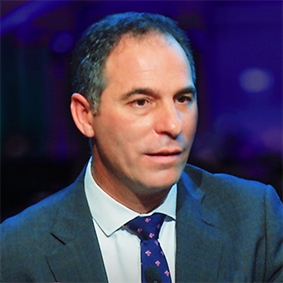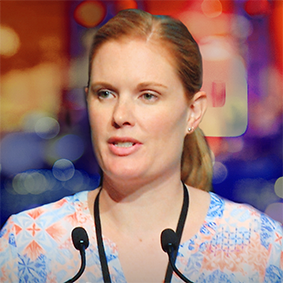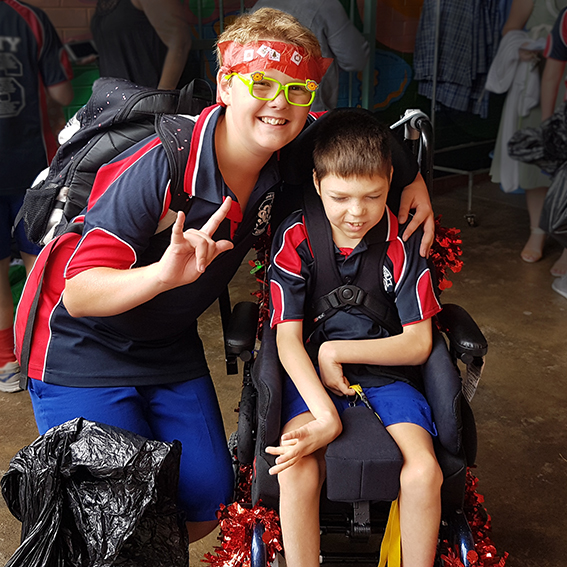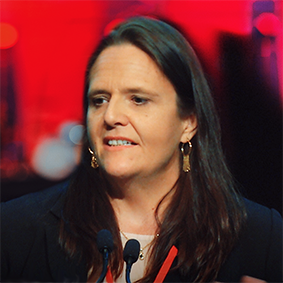ACCESS TALKS: WHY INCLUDE
A founder of the Maryland Coalition for Inclusive Education (USA) Dr Carol Quirk works inside individual schools to bring about whole school transformation. Here she shares research findings on the benefits of inclusive education that show more engagement, more instructional time, better academic skills, adaptive behaviour and social skills.
This transcript has been corrected & edited slightly for clarity.
So why include?
Now, I imagine all of you wouldn’t be here if you didn’t think inclusion was a good idea so I’ll just run through some of the research so you can have it at hand.
This young guy has autism. He has ADHD and he is nonverbal. Why should he be included? Well, we know from research that there are many benefits of putting students in general ed. classes and actually including them in instruction. We know that students are more engaged and there’s more instructional time for students with disabilities when they are included. We know that they make more academic progress.
This is a summary of different studies. There are several different studies that have looked at the instruction of students with disabilities in general education and without exception they have found that students have gains in academic skills, adaptive behaviour and social skills when they are included, compared with a similar group of students in self-contained classes.
Research is also focused on friendships. Now a lot of these studies are very small. It might be with a group of students with Down Syndrome, or a group of elementary students, however, when you look at all of these studies together, you see a clear pattern of the social benefits of inclusive education. Sometimes we have true friendships and sometimes we have social opportunities. In either case these are experiences that students would not have if they were in a separate, self-contained classrooms.
When I was first starting this work, what families would tell me were stories about how students were, for the first time, invited to a birthday party of someone in their neighbourhood or that they had a sleepover with another child, things that their child would not have experienced previously.
There is some really interesting research that has been going on in the US; a national longitudinal transition study where they followed students over two years, five years and now they are working on ten years. In this particular report, they noted that students who were spending 80 per cent of the time, or more, in general education classrooms were twice as likely to enrol in college when compared with students who spent less time in inclusive classes.
Another similar study out of this longitudinal study found that students who were included in high school were more likely to be employed after high school. These are really important implications for being included in the later years. Some recent research is really interesting because it is looking at location. A colleague of mine, Jenny Kerns at the University of Kansas, has two or three studies out now where she has looked at the placement patterns in different states, east coast, west coast, rural, suburban and urban, looked at racial compositions and, basically, what she has found is that when students are living in suburban, more well-to-do areas–and it’s more highly likely that they are white—they are more likely to be included, in contrast to urban settings with a wider racial diversity and more poverty. So here we have a situation where the practices in a location are influencing the outcomes of students, with a more negative outcome for students with high rates of poverty and students who are more likely to be non-white. So, we have a discriminatory situation that results from policy in practice.
What about students without disabilities?
These students are making more progress in reading and math as well. There was a large study of about 2,000 students in the state of Indiana where they compared students in what they called ‘traditional’ classes with no students with disabilities and those in ‘inclusive’ classes that did have students with reading and emotional disabilities. The students without disabilities had greater gains in reading and math compared to the non-inclusive settings. The authors figured that they did not actually measure teaching, but looked at the amount of collaboration that was occurring and concluded that the teaching style actually improved when teachers had students with disabilities in the class.
There are several other studies of students without disabilities, they’re often small and they often look at very specific skills. There is no study that has shown students without disabilities are negatively impacted by inclusion, so besides the learning that occurs for students with and without disabilities, the other arguments have to do with equity, opportunity and society. Students with disabilities should have a right to the same high-quality education as students without disabilities. We know that there is increased opportunity for learning, friends and experiencing the rhythms and routines of life that other kids have. There’s no reason why kids with disabilities should not have those same opportunities.
As a society, we are preparing children without disabilities to be the future employers, parents, neighbours, friends, co-workers of people with disabilities so what a greater opportunity do we have to create a diverse and inclusive society of the future by including our students now.
Last updated August 21, 2018
- Why did your family choose a mainstream education for your son? Jo Basha, Family Advocacy Parent Leader [YouTube]
- A summary of the Evidence on Inclusive Education, Alana [PDF]
ALSO IN THIS SECTION:
MORE ACCESS TALKS:

WHAT IS INCLUSION
The promotion, adoption and implementation of inclusive practices, which involves changing policies, practices and attitudes within schools.

TEACHER IMPACT
All classroom teachers have a role in creating schools & learning environments where all children can learn and feel they belong.

CHANGING MINDSETS
Whole school transformation requires courage, leadership & honest reflection to identify the need for change and set about making it happen.

AUSTRALIAN EXPERIENCE
Exemplar inclusive educational practices are happening in Australia. See the possibility and potential of inclusion here and now.

HOW WE INCLUDE
Creating inclusive classrooms & schools starts with vision, policy, systems change, curriculum design and teaching practice.
NOW EXPLORE ACCESS READS

WHAT IS INCLUSION
The promotion, adoption and implementation of inclusive practices, which involves changing policies, practices and attitudes within schools.

HOW WE INCLUDE
Inclusive classrooms and schools embrace universal design as the foundation for cultivating inclusive attitudes and practices.

CHANGING MINDSETS
Bringing about change one mind at a time is integral to improving the lives of people with disability.

AUSTRALIAN EXPERIENCE
Exemplar inclusive educational practices are happening in Australia. See the possibility and potential of Inclusion here and now.

WHY INCLUDE
All children have the right to be included, to be represented in, to have access to and to receive high-quality education and supports.

TEACHER IMPACT
All classroom teachers have a role in creating schools & learning environments where all children can learn and feel they belong.
A FAMILY ADVOCACY INITIATIVE
This site is edited and maintained by the Advocacy and Leadership Development team.
Image attributions: photos supplied and screen shots from Access Symposium videos.




